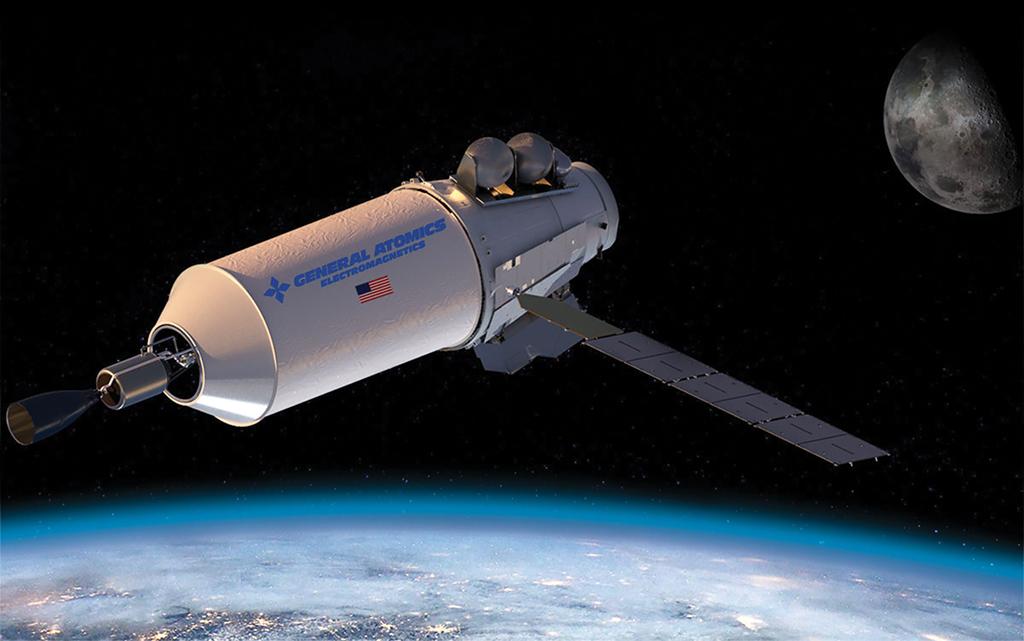
A nebulously named “Deterrence Layer” is on the drawing board for the National Defense Space Architecture, and that could mean the return of a functioning U.S.-operated, nuclear-powered satellite in orbit by 2025 for the first time in 60 years.
The need for the Deterrence Layer may depend on what China and Russia do next. If rival militaries establish a presence in the region of deep space between geostationary and lunar orbits, the U.S. Defense Department believes a future spacecraft—an “advanced maneuvering vehicle” (AMV)—will be needed to charge out as far as the Moon, hopefully just to remind an adversary to keep a tight leash on any nefarious plans in cislunar space.
- On-orbit demonstration scheduled in 2025
- Material sciences drive technology challenge
However, that distant requirement, which is perhaps a decade out, presents an engineering challenge for the Space Development Agency’s Emerging Capabilities Cell. That unit is developing concepts and designs for the future AMV.
Spacecraft designers now have two proven propulsion technologies: electric and chemical. Electric propulsion in space is more efficient, but the hardware comes with a low thrust-to-weight ratio. The latter’s hardware offers a high thrust-to-weight ratio but comes with comparatively poor efficiency.
What is envisaged for the AMV is a propulsion system that produces a high amount of thrust compared to its weight yet is significantly more efficient than chemical propulsion.
Enter the Demonstration Rocket for Agile Cislunar Operations (DRACO) program. DARPA has selected Lockheed Martin and Blue Origin to develop competitive designs for a demonstrator spacecraft and follow-on operational system powered by nuclear thermal propulsion (NTP). The agency also has selected General Atomics Electromagnetic Systems (GA-EMS) to design the nuclear reactor.
The three bidders have about four years to launch the DRACO demonstrator into Earth orbit. The goal is to prove that a new generation of nuclear reactor technology can power a future AMV in space while passing muster with a gauntlet of military and civil nuclear regulatory bodies. Beyond any future AMV program, a successful demonstration by DARPA also could pave the way for civilian, government and commercial access to NTP technology by dramatically increasing the speed and efficiency of travel in deep space.
The idea of nuclear-powered spaceflight by the military is hardly original to DRACO. The U.S. Air Force operated the 950-lb. Systems for Nuclear Auxiliary Power (SNAP-10A) satellite, which used an onboard nuclear reactor to generate at least 500 watts of electricity for 43 days in 1965 until the failure of a nonpropulsive component. Although no longer in service, the SNAP-10A reactor is expected to remain in orbit for the next 3,000 years.
Twenty years after the launch of SNAP-10A, the Strategic Defense Initiative revived the nuclear-powered rocket concept as a proposal for the upper stage of a boost-phase interceptor that could shoot down intercontinental ballistic missiles over the Soviet Union from Alaska. As the Cold War ended, the so-called Timberwind project was transferred to the Air Force to pursue as a science experiment, but it was canceled in 1994 before a reactor could be tested.
Combined with ground-test data from the NASA Nuclear Engine for Rocket Vehicle Application (NERVA) program—which began in 1955 as the Air Force’s Project Rover—the idea of building and launching a propulsion system driven by a nuclear reactor that can work in space is not considered the most challenging aspect of the program.

“I like to joke that the ‘DARPA-hard’ part about DRACO is actually not so much the spacecraft or the technology, although there is some hard stuff there, it’s actually the regulatory piece of getting approval to fly a nuclear reactor,” says Bill Pratt, a Lockheed senior program manager for DRACO.
The DRACO propulsion system is designed to generate intense heat from nuclear fission and use that warmth to expand an onboard supply of liquid hydrogen, which is then diffused as exhaust to generate thrust. The concept will test the state of the art of material sciences.
“You’ve got a giant tank with liquid hydrogen in it and bolted to the bottom of it is a reactor that’s generating thousands of degrees Kelvin,” Pratt says. “So how do we isolate that heat from our propellant, which really hates to get warm? You can use that warmth to a certain degree, to help pressurize tanks and things like that, but there are some serious challenges there in the material science domain.”
In the NERVA ground tests and SNAP-10A orbital tests, NASA and the military used a fission reactor fueled by highly enriched uranium, the same radioactive material used to make nuclear warheads.
For DRACO, DARPA has specified a technology shift to high-assay, low enriched uranium (HALEU) fuel. Unlike weapons-grade uranium fuel that is typically enriched to 80%, HALEU is by definition only enriched between 5% and 20%—although the exact level is not being released. HALEU in the form of uranium metal will be furnished by the government to GA-EMS for the DRACO reactor.
The choice of HALEU exploits a bureaucratic loophole created by former President Donald Trump. His presidential memorandum signed on Aug. 20 delegates approval for the launch of a spacecraft using uranium that is enriched below the 20% threshold to the head of the sponsoring agency instead of the White House. In effect, the memorandum transfers the launch authority decision for DRACO from the president to the secretary of defense, perhaps along with the risk in case anything goes wrong.
The physics of rocket propulsion favor a nuclear reactor with highly enriched uranium (HEU), but the public interest within a regulated technology led DARPA to select HALEU.
“When you’re the public, HEU sounds worse than HALEU,” says Christina Back, vice president of nuclear technologies and materials at GA-EMS. “So if you can make a satellite and a nuclear rocket with HALEU, you would.”
Concerns about launching a nuclear reactor into space have persisted for decades. Although the SNAP-10A has remained safely in orbit since 1965, a nuclear reactor on the Soviet Union’s Kosmos 954 failed to separate before the satellite reentered the atmosphere in 1977. The incident scattered radioactive debris in a remote part of northwest Canada, forcing a cleanup effort partially funded by the Soviet government. The incident reinforced the importance of designing a satellite that can remain in orbit for millennia as well as pose extremely little risk of a radioactive material escape in the event of an explosion during the launch sequence.
“You try and engineer the design so that there are things in place that keep it from being a big problem,” Back says. “So that might be different materials; that might be the way it’s packaged. You must be familiar with nuclear weapons. You can’t just have an accident with a weapon, even if a truck barrels into some shipping container. The same kind of things apply in this kind of scenario.”
For the DRACO demonstrator, DARPA has outlined a path that seeks to eliminate the risk of causing another incident like the reentry of Kosmos 954. The demonstrator reactor is required to be a “nonseverable” component of the propulsion system. In other words, no repeat of the reactor jettison failure, as was the case during the Kosmos 954 deorbit, would be possible. Moreover, DARPA’s plan is to launch DRACO into an orbit similar to that of SNAP-10A, with no chance of an atmospheric reentry for thousands of years—if ever.
“The demo system won’t operate in an orbit where it has any—even a remote—possibility of coming back to Earth,” Pratt says. “Once it’s out there, it’s not ever coming back.”
The history of NTP reactors in space is full of conceptual studies and demonstration one-offs, on the ground or in space, that failed to make the transition to an operational system. If the on-orbit demonstration is successful, DARPA has structured the DRACO program in a way that could lead to a more seamless transition to an operational follow-on.
While they are designing a demonstration system for DRACO, Lockheed, Blue Origin and GA-EMS also will be designing an operational system based on the same technology. In addition to priming industry to proceed swiftly into follow-on development, the dual-track structure will allow the contractors to make design trade-offs between the operational and development systems. The goal is to limit the demonstrator only to the technologies necessary to prove the safety and effectiveness of the follow-on operational spacecraft.
“If you want to go from a demonstration system to an operating system, you want to change as little as possible,” Back says. “If you do put up a demonstration system, you want to be able to go straight to the operating system.”



Comments